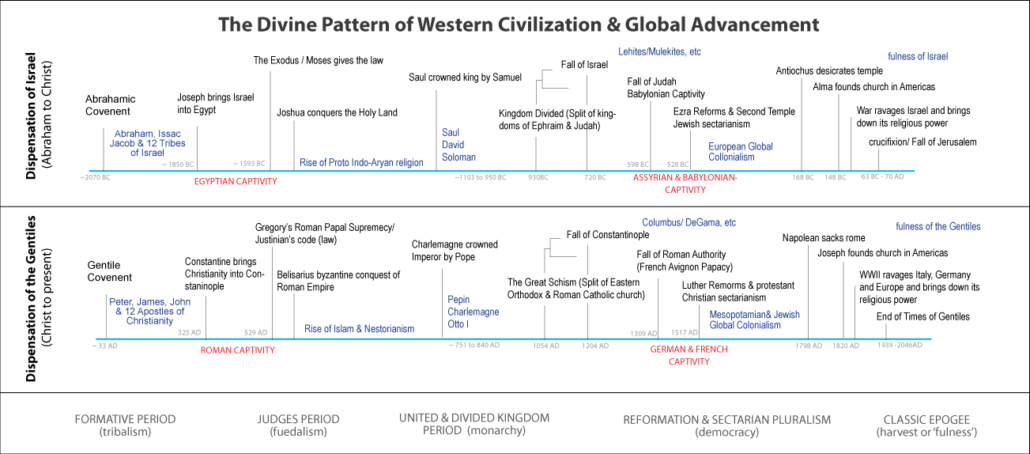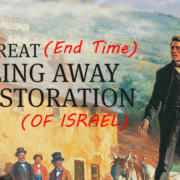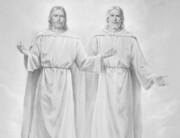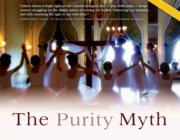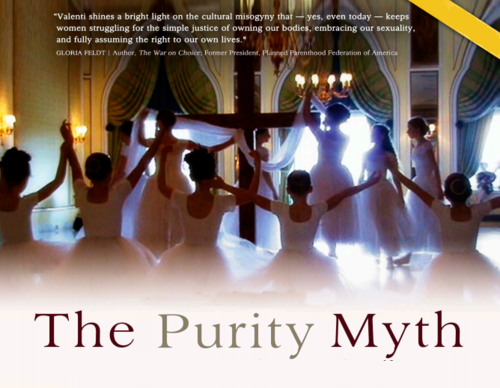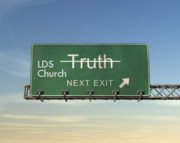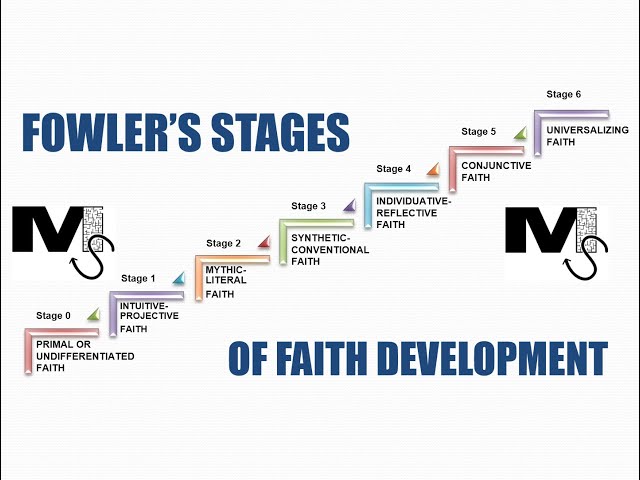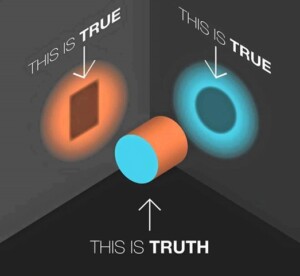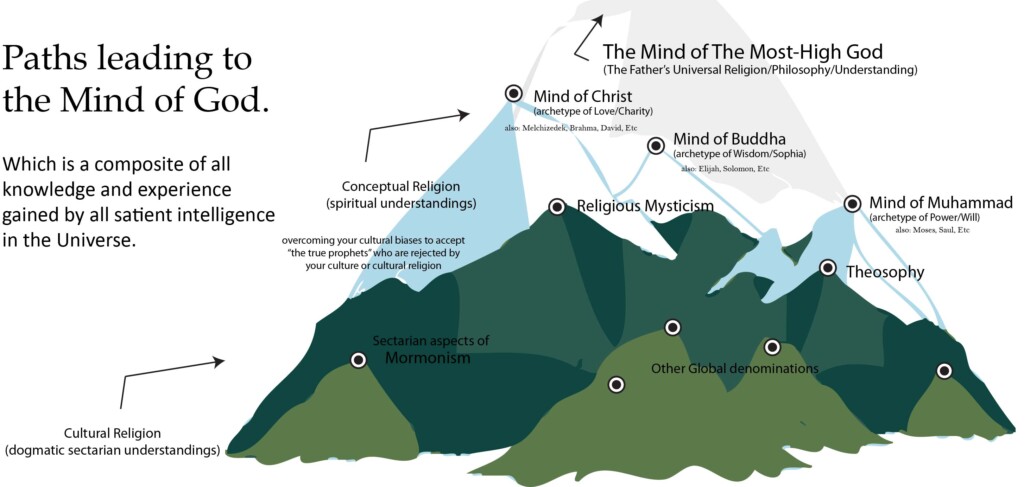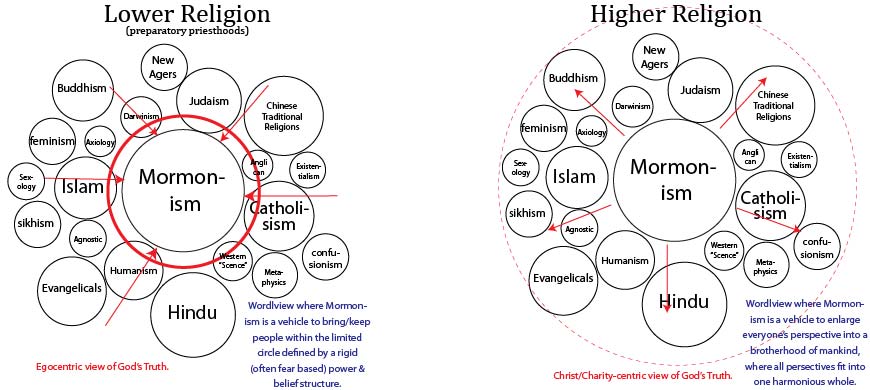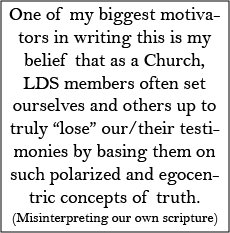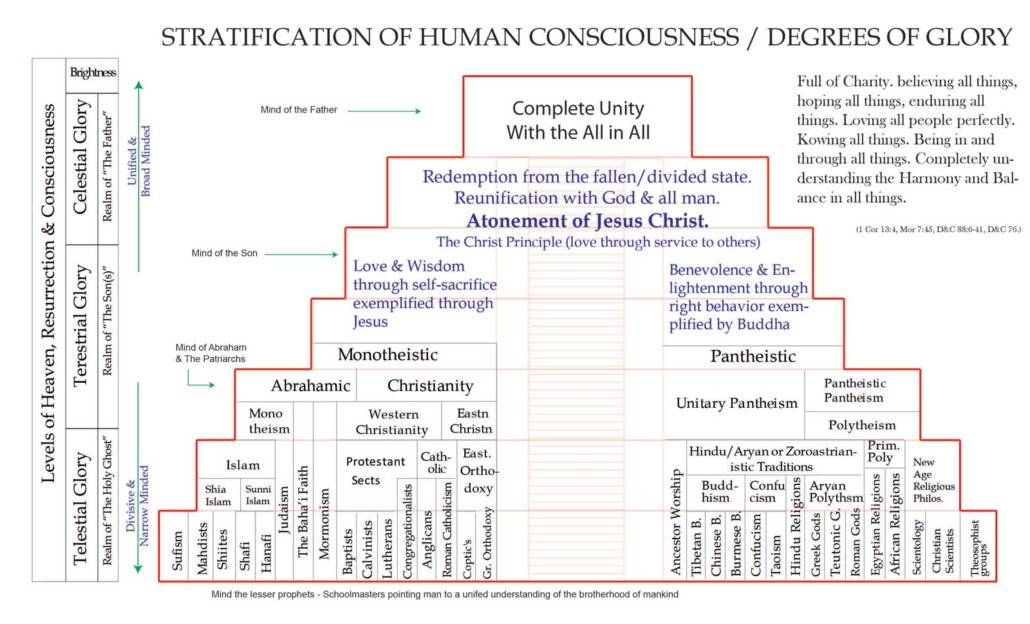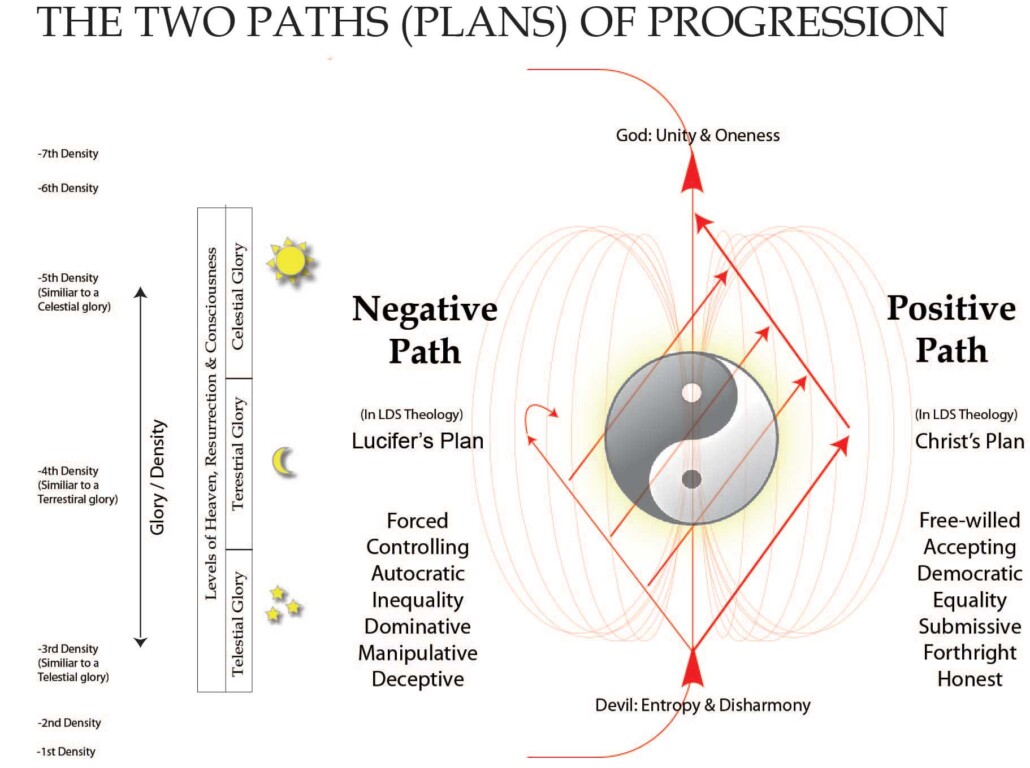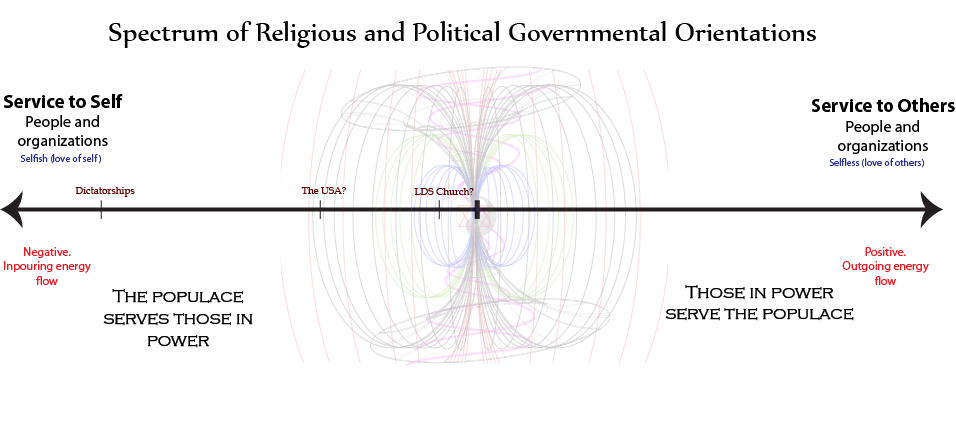
I hope in this article to try to share some things that have helped me figure out how my religion fits with all the other religions in the world (pluralism); thoughts which have helped to break down barriers that inhibited my abilities to accept, love and learn from aspects of humanity not sharing my faith. Ideas that made me afraid of learning and seeking for truth. In a way I am trying to stand between believers and unbelievers and help them see eye to eye. As an active member of the LDS Church, I hope that by reading and thinking about this article, other active members will also be able to break down barriers that might inhibiting their love of others, as well as gaining a different perspective which may better allow you to learn about conflicting ideas or worldviews and still keep your ‘testimony’ and fellowship. For those who have left the church and are unable to find the language to explain your differing views to orthodox Mormons, I hope this article might give you some ideas on how to approach the difficult topics you may have wrestled with. I hope it serves as an authentic apology for our pride and often unchristlike behaviors. I hope that if you are a truth seeker the ideas I perhaps poorly try to explain will help you as they’ve helped me.
Personal Introduction
As a preamble I’d like to share an experience that changed my perceptions on truth. On my LDS mission I met a christian man who was strangely inquisitive, kind, polite and had love for me in his eyes with everything he said. After talking to him for only a short time it was obvious by his questions and love that he ‘knew Christ’ better than me, even though he wasn’t interested in converting to my religion. That stood as a stark contrast to most of the religious and unreligious people I talked to. As an ignorant 19 year old, I could still tell by the poor way most people treated me that they obviously cared more about themselves than me or my truth. Most weren’t very interested in knowing me or in listening to what I had to say. Many of them believed they already had the “truth”, and that what I had was false. In that missionary environment of trying to convince others of my truth, it didn’t take me too long to begin to search myself for hypocrisy. Was I more like that loving inquisitive man or like most others who did not want to talk to me, caring more about their truth than knowing about my truth? What really was truth? How could I know that what I had was better than what they had if I did not really understand what they had? From that time I resolved to be like that kind man and seek and accept truth regardless of its source or my preconceived biases. This was a surprisingly scary endeavor and required more bravery and honesty than I’d have guessed—because at that time I still saw religious truth in black and white terms, I thought it meant that if I found out that my church “wasn’t true” I would have to leave my mission and likely be ostracized to some degree when I came home to Utah. Really confronting that possibility was difficult, but I really wanted to show myself that I was willing to do what I was asking many others to do. What I think few cultural Mormons or mainstream religious “believers” would do—which is search out and give up our own pride for “truth”.

From that early point in my mission I began to hungrily eat up all the information on religion I could find. I quickly read ALL the LDS scriptures (including the entire Old Testament in less than a month). I read any anti-Mormon information I could get my hands on (which wasn’t hard to find in the evangelically populated areas of southern California). I read a great deal of classic Mormon scriptural commentary and apologetic material. As a young teen I had a very profound metaphysical experience when I first read the Book of Mormon (which I finished in less than a week). My “testimony” had always been based on that extraordinary classic “burning heart” experience which I had several times while I read it; however I met numerous people on my mission who had very similar spiritual experiences which formed the basis on their belief in their differing religions. That knowledge always unsettled me a bit. But I pressed on learning, determined to find truth regardless of its source or packaging.
Continuing my search for truth after my mission, over the last 15 years I’ve read or delved deeply into many of the world’s most popular religious works; such as the Koran, the Tao Te Ching, The Avesta, The Vedas, The Apocrypha, Baha’i Scripture, The Zohar, The Kolbrin, and a wealth of new age and channeled material such as Oahspe, Emanuel Swedenborg, J.S. Ward, The Urantia Bible, The Theosophical movement, The Gospel of the Holy Twelve, the Aquarian Gospel of Jesus Christ, the Seth Material and The Law of One. And perhaps most interestingly, I’ve read through hundreds and hundreds of Near Death Experiences. Through all of this I would have to say my “testimony” of the LDS Gospel has been seriously challenged. In fact I could honestly say it has repeatedly been shattered–but in a good way which forced me to rebuild it with increased understanding, faith and love (For my own LDS Faith and all others). I’ve learned over this period that in my youth, my circle of Mormon culture taught me a very limited and childish understanding of both testimony and truth. We hear these words repeated and passed around so much in Mormonism that I think few ever even stop to think what they mean. We say things like “I have a testimony that the Church is true”; but what does that even mean? Imagine someone saying “I have a testimony that my school is the true school or their country is the true country”. Wouldn’t your response be something like “what do you mean?”… “that really doesn’t make any sense, and seems a bit prideful.” Or if they said “I have a testimony that Thomas Jefferson was a true president”, wouldn’t you think it was kind of a confused thing to say? And yet through repetition we LDS members teach our children these couplets and get them to recite them in church even though they kind of distort the meaning of the word or concept of truth.
What is truth?
 The idea of whether a church, an individual or an organization is “true” is a convoluted one. Truth as an absolute, is essentially a complete knowledge of things as they really ARE from all possible perspectives. Its not the purpose of this article to go into too much detail on philosophical definitions on truth, (called epistemology) but hopefully all readers can agree that the above secular definition agrees with the LDS definition of truth given in D&C 93:24, and that given this definition it is impossible for any mortal or organization to really be “true” in the full sense of the word because every human has only their own unique limited and biased perspective. When most religions try and claim to be the “true one”, they are actually saying “our views on eternity and our interpretation of ancient scripture is the only one that is right“. But at best, each religion in this world obviously teaches but shadows of the greater unseen spiritual realities of the heavens. I would ask Mormons, what do we mean by our truth claims anyway? Really ask yourself that and you will see how arrogant and misleading these types of statements actually are. Perhaps we should more rightly say that we believe that the church is true in the sense that it is legitimately authorized. And that “only God is true” or knows all truth or knows the real truth of a matter since we suppose he is the only being who can be conscious of all things from every possible perspective, fully understanding all the details and contradictions. To most non-Mormons and youth, calling oneself “the only true church” is actually paramount to making that church and its hierarchy into a God. As Mormons we believe that Joseph Smith had many amazing supernatural experiences and that through him, “God” restored a great amount of truth which had been lost to mainstream Christianity. We also believe He gave our Church a great restorative work to do and that He restored certain priesthoods and authorities to aid in that work. But interpreting D&C 1:30 to suggest that we are the “only true church” suggests many things to the world and our youth which actually go against our goal of proving to the world that the heavens are still open and that Higher Beings speak truth individually to mankind through his Spirit as well as collectively through 19th century farm boys and assorted modern prophets.
The idea of whether a church, an individual or an organization is “true” is a convoluted one. Truth as an absolute, is essentially a complete knowledge of things as they really ARE from all possible perspectives. Its not the purpose of this article to go into too much detail on philosophical definitions on truth, (called epistemology) but hopefully all readers can agree that the above secular definition agrees with the LDS definition of truth given in D&C 93:24, and that given this definition it is impossible for any mortal or organization to really be “true” in the full sense of the word because every human has only their own unique limited and biased perspective. When most religions try and claim to be the “true one”, they are actually saying “our views on eternity and our interpretation of ancient scripture is the only one that is right“. But at best, each religion in this world obviously teaches but shadows of the greater unseen spiritual realities of the heavens. I would ask Mormons, what do we mean by our truth claims anyway? Really ask yourself that and you will see how arrogant and misleading these types of statements actually are. Perhaps we should more rightly say that we believe that the church is true in the sense that it is legitimately authorized. And that “only God is true” or knows all truth or knows the real truth of a matter since we suppose he is the only being who can be conscious of all things from every possible perspective, fully understanding all the details and contradictions. To most non-Mormons and youth, calling oneself “the only true church” is actually paramount to making that church and its hierarchy into a God. As Mormons we believe that Joseph Smith had many amazing supernatural experiences and that through him, “God” restored a great amount of truth which had been lost to mainstream Christianity. We also believe He gave our Church a great restorative work to do and that He restored certain priesthoods and authorities to aid in that work. But interpreting D&C 1:30 to suggest that we are the “only true church” suggests many things to the world and our youth which actually go against our goal of proving to the world that the heavens are still open and that Higher Beings speak truth individually to mankind through his Spirit as well as collectively through 19th century farm boys and assorted modern prophets.
I believe the cultural idea and practice of claiming to be the “only true church” has created an environment where our members are actually more closed to truths (which instead of coming through accepted cultural Mormon channels, might come through science or other religious leaders) than the average person in the world in general. In a religion founded on the principles of religious pluralism and continuing revelation this should not be. In the following pages I will attempt to show through LDS scripture the sources and error of this doctrine. And make a case for the idea that if one really wants to know truth, one needs to gain as many perspectives on a thing as possible. Which requires loving and empathizing with others enough to see things the way they do. And that as we go through this process of loving others and adding their perspective to our own we get closer to the ever illusive real all-truth which is only known by God (more on the definition of “god” later).
The Key to Truth: The Proverbs of the Elephant & Mountain
There is a sage Hindu proverb about six blind men and an elephant who each feel different parts of the same animal but each have completely different ideas about what they are experiencing because of their limited perspectives. One thinks it’s a rope, another a pillar, the other a fan, etc, but all are wrong because they can’t see the whole picture. The Gospel of the Holy Twelve shares a similar parable which Jesus supposedly gave to Thomas and his Twelve Apostles in order to illustrate this concept about truth. I think it’s one of the most profound Christian discourses on truth I have read….
2. And as they were speaking Jesus appeared in their midst and said, Truth, one and absolute, is in God alone, for no man, neither any body of men, knoweth that which God alone knoweth, who is the All in All. To men is Truth revealed, according to their capacity to understand and receive.
3. The One Truth hath many sides, and one seeth one side only, another seeth another, and some see more than others, according as it is given to them.
4. Behold this crystal: how the one light is manifest in twelve faces, yea four times twelve, and each face reflecteth one ray of light, and one regardeth one face, and another another, but it is the one crystal and the one light that shineth in all.
5. Behold again, When one climbeth a mountain and attaining one height, he saith, This is the top of the mountain, let us reach it, and when they have reached that height, lo, they see another beyond it until they come to that height from which no other height is to be seen, if so be they can attain it.
6. So it is with Truth. I am the Truth and the Way and the Life, and have given to you the Truth I have received from above. And that which is seen and received by one, is not seen and received by another. That which appeareth true to some, seemeth not true to others. They who are in the valley see not as they who are on the hill top.
7. But to each, it is the Truth as the one mind seeth it, and for that time, till a higher Truth shall be revealed unto the same: and to the soul which receiveth higher light, shall be given more light. Wherefore condemn not others, that ye be not condemned.
8. As ye keep the holy Law of Love, which I have given unto you, so shall the Truth be revealed more and more unto you, and the Spirit of Truth which cometh from above shall guide you, albeit through many wanderings, into all Truth, even as the fiery cloud guided the children of Israel through the wilderness.
9. Be faithful to the light ye have, till a higher light is given to you. Seek more light, and ye shall have abundantly; rest not, till ye find.
10. God giveth you all Truth, as a ladder with many steps, for the salvation and perfection of the soul, and the truth which seemeth today, ye will abandon for the higher truth of the morrow. Press ye unto Perfection.
Full truth is a view of the whole mountain from every angle, which can only be seen looking down from the highest peak (which is infinite and impossible for mortals to reach). It is to see all of eternal creation as it really is. Thus for man truth is a process as much as a destination, and the only way to head toward it is love. Because love is the unifying principle, and truth is a journey to perfect unity of perspective or at-one-ness with all sentient life in the universe. The same is true for perfection and righteousness, they are journeys heading toward unity and wholeness, which is accomplished through harmony and balance.
I believe we must traverse the lower foothills in order to progress toward higher perspectives. The lower foothills are full of moral and ideological absolutism because they are not yet aware other paths exist, nor are they really even aware of their own real goal. But the higher we climb, the more we see the higher peaks, and that we are only on a foothill, and that there are other foothills, and that there are other people on those foothills headed toward the same goal.
The pride of imperfect men and organizations are always trying to turn complex concepts into black and white, true or false dogmas. I think in Mormonism we too often get stuck into that narrow mindset instead of following a more pluralistic approach such as exemplified in this quote from Joseph Smith,
“I never thought it was right to call up a man and try him because he erred in doctrine, it looks too much like Methodism and not like Latter day Saintism. Methodists have creeds which a man must believe or be kicked out of their church. I want the liberty of believing as I please, it feels so good not to be tramelled.” (The Words of Joseph Smith, pp. 183-184)

Full Truth is a composite of all knowledge. Religion is a “schoolmaster” designed to help us gain the mind of god.
Another Story
When I was younger, I put Joseph Smith way up on a pedestal and interpreted scripture and history through what I felt was the true worldview which he restored. I saw only one narrow interpretation of his experience which was that the Most-High God of the infinite universe appeared to Joseph in person, because of his worthiness/forordination, and started His One and Only True Church on earth through him. That this Most High God picked Earth of all the gazillions of planets in the infinite universe to bare His ONLY True Son in the flesh, and this royal heir to the throne started His ONLY true church with the keys to eternal exaltation. That essentially every thought, action and aspect of human existence was ruled by the devil except for the things the Bible, Joseph or my Church leaders sanctioned. I was taught to attribute every personal spiritual experience or powerful emotional reaction to truth, as proof that this worldview was the true one.
But the older I get and the more I look outside myself, experiencing God, studying history, scripture and human experience — the more the rigid aspects of this definitive worldview break down. Why earth? Why Israel? Why Joseph? Why a church hierarchy? What about China? Who’s this Buddha guy? Why was Joseph so good and Warren Jeffs Bad? Why was Moses & Joshua true but Mohammed false? Why is the Bible/Book of Mormon the true word of God but the Bhagavad Gita, Rigveda or Oahspe not? Just like the Book of Mormon I have strong spiritual feelings when I read them. But I also have strong spiritual feelings when I hold my children or kiss my wife–does this mean they are the only truth? Just like Joseph I am a thinker and have continually asked God for wisdom; but much like Buddha or Mohammed my visions from God have been uniquely different than Joseph’s (although with many commonalities as well).
To further illustrate the point of pluralism, I recently talked to an LDS youth who had an experience seeing a “being of light” (as he described it). He told me about how in an altered state of consciousness induced by fasting, this being had appeared to him and told him to start his own church. I have talked to others who have seen visions and light beings as well. I have had my own wild metaphysical experiences. I have read the experiences of scores of others. Some resonated with me (ie. I felt the Spirit) and some did not. But the more I explore these the more I see that whether or not I “feel the Spirit” in someone elses experience has more to do with my own worldview and biases than anything else.
I think that this is a really important point and a major key to pluralistic understanding, empathy and love. The world of truth is not black and white. We are all running about this huge mountain trying to figure out what it is. Trying to decide what our own as well as others’ experiences and perspectives mean.When one runs into a differing perspective, the question is not whether it is true or false but what are you going to do with it? Will you use it to unify or divide? To help people climb up the mountain or to hold them down? My goal in this article is to unify, and to show LDS people ways which some of our prideful traditions or scriptural interpretations might be polarizing people into division and unbelief. How some of our reactions to other perspectives might force people further and further out of the Church. As an example, I offer this pretty typical reaction of an (LDS?) mother’s reacting to her son when he tells her he’s decided to be an atheist. (warning: profanity alert!)
Now there’s probably more to this particular family issue than shown in the video, but in general why is it that there is so often negative emotional reactions to others who have different religious viewpoints? Why the anger? I believe it usually boils down to power struggles and the concept that most people would rather be right than learn truth; and not understanding that truth is seeing how everyone’s perspective fits into the big picture. Going back to our mountain analogy, if you’ve put a lot of energy hiking up a mountain and someone comes and tells you about their different awesome mountain, it might make you fear that maybe you’ve been hiking the wrong mountain which might piss you off if it threatens your feelings of life-purpose and value. But if you understand that life & truth is a process of exploring every mountain (and finding how they’re connected) and not just a race to reach the top then you can instead listen to the differing perception and see its beauty, instead of being threatened because you were so sure your little hillock was the highest peak and that you had “arrived” at truth. Giving up our pride allows us to love everyone, and see how everyone’s religious or personal viewpoints fit into one big beautiful picture. It is important to realize that “Christ” came to His people, to be rejected of them in order to teach us this very lesson. The fact that Christ is and would be rejected by the mainstream of every religion that thinks they already have the truth is very important to our journey of growing in truth.
You have to lose your testimony to truly gain it
At some point in the maturing process everyone has to stop relying on the “testimony” of their parents and find their own light. There is often a similar process wherein we transcend the testimony of our church leaders and find God & truth for ourselves. I believe a major key in this process is remembering the parable of the mountain; we approach the ultimate truth by seeing EVERYONE’S perspective (including those in heavenly realms) and finding how it fits into the big picture. So there is no need to fear information because even “false” information is a part of the truth. The key is releasing our desire to be “right”, to define your truth as the only truth. By assuming your truth is the highest truth you assure that you would have been one who rejected Christ, because he came for the express purpose of testing whether we loved others enough to learn truth even if it conflicted with our deeply held beliefs. By assuming your truth is the highest truth you assure that your truth is falsity because it is fated to remain so partial. It’s like a man who never makes it past the mountain’s first foothill because he’s deluded himself into thinking he’s reached the top. This is taught beautifully in the Book of Mormon in these verses..
7 Know ye not that there are more nations than one? Know ye not that I, the Lord your God, have created all men, and that I remember those who are upon the isles of the sea; and that I rule in the heavens above and in the earth beneath; and I bring forth my word unto the children of men, yea, even upon all the nations of the earth?
8 Wherefore murmur ye, because that ye shall receive more of my word? Know ye not that the testimony of two nations is a witness unto you that I am God, that I remember one nation like unto another?
Once we learn everyone’s perspective then our religion becomes a matter of choice instead of a matter of force (force and manipulation ruin religion’s power to save anyway). When we realize no earthly church, but only the heavenly church, is “true” or “perfect”, but that a church is a vehicle to aid us in our progression then we CHOOSE our religion as we choose our spouse based upon what gives us the best opportunities for growth and service. If we choose Mormonism we do it because we want to be part of the work its been given to do… not because its the only vehicle to salvation. And this frees us to truly learn truth because we are no longer trapped in the constant fear that if we learn our church isn’t “true”, it might disrupt our comfy world-view and lifestyle. Thus you have to lose your testimony or desire to be “right” in order to gain a true testimony or free yourself to explore all truth. I’m not advocating leaving Mormonism or any church… in fact quite the opposite. I believe God puts us in churches based on certain pre-incarnate lessons we want and need–but that doesn’t mean our wants and needs won’t change. This is really the same concept taught by Christ when he says you have to lose you life in order to gain it. I believe he is teaching the principle of losing our ego, pride or desire to be the center of the world in order to be free from the fear which keeps us from going out and loving people and finding “life”. This is why Christ was excommunicated and found few believers from the orthodox pharisee sect. This is why “new” dispensational & religions and revelations like Mormonism, that make people question their culturally ingrained truths and traditions, have so much of God’s Spirit. This is also why I say cultural “Mormons” need to lose their testimony to gain it. (More on priesthood and prophets later) Have you ever thought that “Gods” purpose in religion and politics is not so much to see if you can chose between mans perspectives of true or false, right or wrong but instead to gain His perspective which is to see through eyes of perfect unconditional love how all things fit into the big picture” (That all truth can be circumscribed into one whole–as the LDS temple teaches us ). The point is to enlarge your perspective, and that is what will get you God’s spirit. That despite all people and religions being selfish, egocentric and kind of messed up they are all true and all beautiful when seen in the big picture. The truest religion is the one with the most all-encompassing perspective, and open to the most revelation. A picture of a sunset may have a lot of darkness in it, but when you step back and see how it contrasts with all the hues of light you see that it is all amazingly beautiful and harmonious.

I believe LDS scripture, priesthood and doctrine were all initially revealed as a “schoolmaster” to enlarge humanity’s view of truth, not to restrict it.
Dealing with Troubling Aspects of Religion
Now one of my biggest motivators in writing this is my belief that as a Church, LDS members often set ourselves and others up to truly “lose” our/their testimonies (in the negative sense) by basing them on such polarized and egocentric concepts of truth (often perpetuated by our leaders). On the other hand, the worldview I’ve outlined lays the framework for dealing with troubling aspects of Mormon history or anti-material of any type. If you have a proper understanding of truth (that its not black & white), and love others more than you love yourself; and your testimony or love of the church is not founded on distorted “idyllic” principles— anti-material or the “messed up” aspects of the church will not affect you much. Because of your Christ-like love, you will neither idolize nor demonize the church. Just like with people, you’ll love them regardless of whether they are perfect or imperfect, truthful or self-deceived. If you read some literature that offers a different negative spin on some cherished Mormon belief or history and you find it challenging your testimony, then you can guess perhaps your testimony is built on a distorted “sandy” foundation. That perhaps it is based on an egocentric desire to be right or perfect instead of a Christ-centric desire to learn truth by loving and empathizing with others; built on selfishness instead of unselfishness. I believe a lot of negative traditions have come into the Church which are increasingly dividing cultural Mormons. We idolize our past and present prophets in very egocentric ways. We idolize our religion, pharisaically suggesting we are god’s elite “chosen” people and the only true church in a sea of falsity. Like most orthodox religions we are often full of ourselves in a way that causes division in ourselves, our families and our communities. Our pride and desire to be “right” and “righteous” divides us in a way that you must either “have a testimony that the church is true” or not. It’s either entirely led and directed by “God” or it’s not. You must be one of us, or a gentile apostate. Joseph Smith must have been a great hero and a prophet, or a polyandrous adulterer and false prophet. Brigham Young was either a prophet commanded by God to take 55 wives and lead the people in righteousness, or a ‘bad man’ who was racist, misogynistic, egotistical, philandering and power hungry. Church policies on issues such as polygamy, the priesthood ban on those of African decent, homosexuality, etc are either divine edicts straight from the Most High God Himself or the church isn’t true. It’s my strong opinion that we should seek to stop promoting this attitude in social material, firesides and occasional general conference talks.  Instead of spreading God’s love and good news, it comes across prideful, manipulative, contrary to our own scripture (D&C 121:41–42), and pushes a lot of good people out of the church. Instead we should realize that the whole spectrum of good and bad exists within each of us as well as every organization. We should try to focus on and promote the good without idolizing or demonizing (polarizing) the extremes of the spectrum.
Instead of spreading God’s love and good news, it comes across prideful, manipulative, contrary to our own scripture (D&C 121:41–42), and pushes a lot of good people out of the church. Instead we should realize that the whole spectrum of good and bad exists within each of us as well as every organization. We should try to focus on and promote the good without idolizing or demonizing (polarizing) the extremes of the spectrum.
In scripture, God often compares Himself to a groom and the church to his bride. This is because the relationship between a church and their god is the same as the relationship between a married couple. The symbolism runs deep in order to teach us important concepts (especially in the LDS temple ceremony). Until true unity is achieved, God is hidden behind a (bridal) veil. As we come to know God we learn of him/her through the veil. We enter a covenant relationship with him/her in hopes to come to intimately “know” him well enough to really “see” him. Idolatry (adultery) is a sign that we don’t really know god, and eternal life is to know Him and become symbolically one with him (John 17). And just like failed marriages most people leave the church because they had a inappropriate expectations concerning their relationship with the Church. (Often perpetuated from the top down as well as from the bottom up.) In a relationship it is common for people to become disillusioned and fall out of love. This is caused when our partner doesn’t measure up to our idyllic preconceived notions of what we think a spouse or lover should be. So in the courting process we essentially create a mold or idol of what our “perfect” partner should be, and then we often hold them to idea that they must conform with our ideal— and the problems come because that perfect image or ideal is usually a projection of our own selfish desires.
Similarly, the majority of people in the organized religions of this world actually inappropriately worship an idol or a personal perception of a god/church who is a projection of their own ego. And when something happens and they discover that the reality of God or the church doesn’t match their ideal/idol of God or the church, they are disillusioned, fall out of love and end the relationship. (Or on the flip side they self-righteously force some poor brother or sister out of the church because they don’t measure up to orthodox ideals.) Often this has to do with a belief that God or the church or church members should be “better” (according to our perceptions) than it/they are. It all boils down to relationships based on or laced with unwise or distorted expectations. Expectations which are created and fostered by distorted traditions and concepts such as “my church is the only true church”, or “my spouse is my one and only destined partner”. Or “Our prophet is God’s only mouthpiece and every significant decision they make straight from the Most High”. These concepts are flattering because they feed our egos, but they miss the important point that we are all equals and should enter relationships for opportunities to grow and serve, not just to feel comfortable, feel “right” or be served.
All earthly religions are imperfect and frankly a bit messed up, but we should all realize that we enter both marriage and religion for the purpose of progressing toward unity which is the gateway to truth and the true God. If our goal is to serve another, would we leave our spouse or children when we learn they are lazy? If our goal is to learn tolerance would we leave an organization when we find it is intolerant? If our goal is to learn forgiveness would we leave our spouse or church when they wrong us? If our goal is to gain another perspective and enlarge our understanding of truth would we leave an organization when we find that there are far different ways of looking at things than what the majority of the group believes? Or on the flip side, is it right to excommunicate, divorce or belittle those who have widely different views or behaviors? We enter relationships in this life to learn from, and enter into those relationships believing what we choose to believe about our lovers. I think in this life we far too often end relationships when they become painful, not realizing that the only reason they are painful is because of our preconceived egocentric perspectives about other’s behaviors. All people and organizations are composed of positive and negative attributes — good and bad — and the happiest people in this life I believe have learned to love the whole spectrum of attributes between these extremes. Similarly, the most beloved leaders and lasting organizations are careful to be honest about themselves and not make themselves out to be more than they are. They treat others as equals and don’t hide behind propaganda or a forged persona.

Every religion fluctuates on a spectrum of “Good and Bad” depending on how beneficial it is to humanity at the time.
The only true church?
Many churches through history have taught or believed on some level that they are the only “true” church. It is an idea highly appealing to the ego; in the same way, many people in relationships want to believe they are their partners predestined one and only. I think emphasis of this truism is a distortion of Joseph Smith’s revelations. Leaders have focused on D&C 1:30, patting themselves on the back as it says “to bring it forth out of obscurity and out of darkness, the only true and living church upon the face of the whole earth”. But I believe they misplace the emphasis and misinterpret what and who this statement is referring to. We overlook that verses 17-18 refer to both Joseph Smith “and others”. We don’t understand that the “true and living church” is a symbolic title/catchphrase much like the “fullness of the Gospel”, not a literal declaration of elitism. We suppose that the ” living Church” is the organization Joseph started and that the “others” are Joseph’s friends and converts, but D&C 10:52–55 makes it pretty clear that God as Joseph Smith revealed Him defined HIS church as one that transcends organizational lines. D&C 10:67–69 says “This is my doctrine—whosoever repenteth and cometh unto me, the same is my church.” Moroni 7:16–19 combined with 1 Ne 14:10–17 add yet more clarification of how God considers all those do Good, seek his counsel, accept his prophets and believe in love or the archetypal Christ are His Church; and those that fight and hate on others are the devil’s church. Christ’s spiritual Church (The Kingdom of Heaven) was in “obscurity and darkness” because the organizational churches of the era were full of elitist pride and contention (doing more harm than good, JS-H 1:19). I think we look beyond the mark when we do the same and think this revelation gives us right to consider the LDS Church God’s only true and living Church or the only aspect of the “Kingdom of God on earth”. Given other scriptures I do not think the emphasis in the verse is on there being only one true organizational or denominational Church, but Like 1 Ne 14:10, it is saying the attributes in the previous verses can make the LDS movement & priesthood part of the restorational spiritual Church of Christ or Heavenly Church which is the “only true and living church.., with which I, the Lord, am well pleased“.
(See my article Re-examining what LDS scriptures say about the ‘Only True Church’ doctrine for a scriptural exposition on this concept

I believe High beings direct lower beings to create religion to point the way to eternal progression; which is love through unity. Man alters true religion to fit his perceptions, cultural & religious biases and ego. We should not shun or demonize organized religion, but we should see it and use it for what it is– a “schoolmaster” pointing to “Christ” or the archetype of selfless service and love.
We also seem to dismiss the fact that within a decade of this revelation, the Lord was no longer well pleased with the LDS organizational Church. D&C 84:54–57 which states that by 1832 the church was “under condemnation” for unbelief, and that by 1842 the Lord was threatening to withhold the “fulness of the priesthood”, in much the same manner which He did to the children of Israel in Moses’ day (D&C 124:28–48). It should be obvious that the world is God’s so all churches are managed by Him according to their agency. Each is free to choose what degree they are influenced by the agents of harmony and unity, or the agents of disharmony and separation. I believe these scriptures make it clear that God considers Churches “living” and “His” for as long as they follow and lead people to unity in Him (by accepting personal & group inspiration and helping to bring love and unity to humanity). But as soon as they become lifted up in pride, believing they are God’s chosen elite with God’s only authority; but cause more separation and disunity than good through their self-righteousness and narrow-minded creeds, then God effectually disowns them & invalidates their priesthood or authority (ie. withdrawing the mandate of Heaven, as with the Jews at Christ’s time). LDS scripture surely seems to suggest that if the LDS church and other restorational Churches continue leading people into love and unity, doing more good than harm—then they will eventually merge into one “Kingdom of God on earth”, which will occur as they unify with “the Kingdom of Heaven” or spiritual church and everyone but those who willing chose division and separation will be saved in a kingdom of glory when Christ “gathers ALL THINGS together in one”, and presents the kingdom of the brotherhood of man to the Father of all mankind (D&C 27:13, Eph 1:9–10, D&C 128:18, 1 Cor 15:24, 3 Ne 11). It is pride and arrogance that derails organizations from this unifying work and the “orthodox” of organized religions should continually ask themselves whether they would disbelieve or even excommunicate their prophet founders were they to come in disguise a hundred years down the road to their own religions. It is likely that Joseph Smith with is 30+ secret wives and unsanctioned revelations would be excommunicated from modern Mormonism in the same way he was rejected by his contemporary religions. It is less obvious but no less likely that Christ with his unorthodox teachings would also be excommunicated from most modern Christian religions as he was by the Judaic priesthood of his day. Nearly all true prophets are rejected by the mainstream, because most people are more concerned with being right than loving and learning truth.
Now before anyone starts squabbling over the issues of priesthood lets cover a few more points and then come back to it. What exactly are we saying when LDS people say we are the only true church or that the church is true? Are we saying we have all the truth? Our own scriptures make it clear that is not the case. Are we saying we are free from error? This is also obviously not the case either. Are we saying we are more true than other churches…? Are we really so petty that we need to be like kids at recess saying “my dad loves me more than your dad, and I understand god better than you, and your priesthood authority comes from the devil”. (see here, here and here for a better understanding on how religious and political priesthood or authority works in a broader sense. See this article for a better understanding of the difference between priesthood and prophets.) Hopefully we all see the silliness of such statements and aren’t insinuating them when we talk about the “truthfulness” of the church. This is illustrated well in a story from The Aquarian Gospel of Jesus Christ. In it the young Jesus comments on a self-righteous statement made by one of the chief rabbis about Israel being a “chosen” people.
13 Now, in the evening [the young] Jesus and his mother sat alone, and Jesus said,
14 The rabbi seems to think that God is partial in his treatment of the sons of men; that Jews are favored and are blest above all other men.
15 I do not see how God can have his favorites and be just.
16 Are not Samaritans and Greeks and Romans just as much the children of the Holy One as are the Jews?
17 I think the Jews have built a wall about themselves, and they see nothing on the other side of it.
18 They do not know that flowers are blooming over there; that sowing times and reaping times belong to anybody but the Jews.
19 It surely would be well if we could break these barriers down so that the Jews might see that God has other children that are just as greatly blest.
(see also Romans 3:9–23, JS-H 1:19, for reiterations of the same point)
Priesthoods & Zoramiteism
When LDS people and apostles use their priesthood as “reasoning” for why they are God’s elect, they disobey the God they/we are trying to serve. In D&C 121:45–47 Joseph Smith is told
“no power or influence can or ought to be maintained by virtue of the priesthood [!]”
It seems like common sense that we should not attempt to influence people, or legitimize our position by using arguments of priesthood. Instead any power or influence we seek to verbally or physically exercise over others should be gained and maintained solely by christ-like principles such as
“by persuasion, by long-suffering, by gentleness and meekness, and by love unfeigned; By kindness, and pure knowledge, which shall greatly enlarge the soul without hypocrisy, and without guile
It’s a bit unwise to teach our children or investigators that they should “follow the prophet” just because he is in our eyes “The Lord’s anointed”. Or that they should be a Mormon because we are God’s chosen people and the only true Church; because the pride inherent in these statements often backfires, and sours or angers people. I think this is why Joseph Smith received this revelation in Liberty Jail after asking “why all the persecution” and “when will you avenge our wrongs?” Within His consoling response the Lord basically reproves both the persecutors and the saints. The Zoramites of the Book of Mormon are a classic example of a people who went to the opposite extreme of this counsel. The Zoramites as a consequence invented a religious tradition which shares many common characteristics with some Mormon traditions and many other sectarian religions. In their “testimony meetings” they stood upon a pulpit and mechanically repeated the same prayer…
16 Holy God, we believe that thou hast separated us from our brethren; and we do not believe in the tradition of our brethren, which was handed down to them by the childishness of their fathers; but we believe that thou hast elected us to be thy holy children…
17 But thou art the same yesterday, today, and forever; and thou hast elected us that we shall be saved, whilst all around us are elected to be cast by thy wrath down to hell; for the which holiness, O God, we thank thee; and we also thank thee that thou hast elected us, that we may not be led away after the foolish traditions of our brethren, which doth bind them down… which doth lead their hearts to wander far from thee, our God.
18 And again we thank thee, O God, that we are a chosen and a holy people. Amen.
19 Now it came to pass that… every man did go forth and offer up these same prayers.
21 Now the place was called by them Rameumptom, which, being interpreted, is the holy stand.
When LDS people and/or leaders assume we are the only ones with God’s prophets, truth or priesthood… well we all know what happens when we assume. This is likely one of the major reasons the Jewish priesthood leaders rejected Jesus as the Messiah, because not being a Levite he did not hold their priesthood, and thus they believed he had no right to the office of High Priest (Hebrews 7 addresses these issues). The same was likely true for many of the Old Testament prophets who were not from the tribe of Levi, and for this and other reasons were seen as not having right to speak in the name of the Lord by the orthodox mainstream. In the Book of Mormon Jesus made it clear that he was commanded NOT to tell his apostles in Jerusalem concerning the specifics of his “other sheep” unless they specifically asked about it. (3 Ne 15:14–18, 16:4-5). The record also suggest than non-Abrahamic branches such as the Jaredites and Israelite offshoots such as the Nephites were somehow given a priesthood even though according to Jewish tradition, they had no right to it because they were not Levites. Mormon’s cannot assume that Buddha or Mohammed or other non-biblical holy men were false prophets or “lesser” holy men on grounds that we think they did not hold priesthoods. We cannot assume that Hindu or Chinese religious founders were not given a priesthood, just as the Brother of Jared must have.
The truth is we just dont know. A thorough reading of scripture shows that as much as LDS people know about religious & political priesthood or governing authority (like the Jews & the Catholics) there is also an awful lot we don’t understand. So likewise we cannot assume that God did not restore additional priesthood to some other unknown eastern Lama or Yogi or other major modern religious players such as the Bab (a contemporary of Joseph Smith who founded the Baha’i Faith). Our own scripture teaches that the immortal John was “ministering” among the 10 tribes of Israel in the Latter-days (D&C 77:14–15). And that at a future point “their prophets” (unknown to Mormons) “shall hear his voice, and shall no longer stay themselves” and will come and make themselves known to the children of Ephraim (D&C 133:23–36). Both the Bible and D&C strongly suggest that in addition to restorational work occurring with the “Lost Tribes”, a “parallel restoration” will occur among the Jews of the Holy Land and that a strictly Jewish Priesthood will restore the Jewish Temple which will begin the Jewish restoration and gathering (D&C 133:12–13, D&C 45:24–31, D&C 98:17, JS-M 1:12–32, Revelation of John Ben Kathryn). Scriptures like D&C 107:64–67 and 132:7 do not preclude the idea of parallel restorationism, given that other LDS scripture clearly shows it occurred over and over in the past (Alma in the Book of Mormon being a good example). In fact D&C 49:8 seems to directly infer it. We also do not fully understand the manner in which aspects of priesthood “continue… in [one’s] seed throughout all their generations” regardless of whether it is “reconfirmed” for ceremonial purposes (D&C 84:17–18,48). This is why priesthood is often “confirmed” on holders and not “given”, because priesthood is a right passed hereditarily and genetically (D&C 107:67–76, see my article The Scattering and Gathering of Israel for more detail on the genetic aspects of priesthood). I believe that pride perpetuated through well meaning LDS leadership has spread a Pharisaical spirit of elitism which not only causes many to leave the church, but also keeps many more from joining our faith (see this general conference address). I am personally grateful for caring friends and family who have kindly pointed out my arrogance and the ways in which I exercise “unrighteous dominion” or unwise influence; and I believe LDS people would do great service to our leaders by meekly advising them of the same. A greater spirit of meekness will aid in the quest of LDS people to aid God in his aim to “gather together in ONE all things” (D&C 27:13). To put down contention instead of causing it (3 Ne 11:28–30). Rearranging our worldview on this issue will also help LDS people to apply 2 Ne 29:11–14 to themselves to prevent rejection of ancient and modern prophets and revelation which don’t originate from our priesthood leaders. (See this article for a better understanding of the difference between priesthood and prophets).

All the major players in the Human Drama have had the choice whether to unite or divide humanity. I believe in this final age, God will favor and sustain only those who unite. All other groups will become extinct. See the article The Scattering and Gathering of Israel for details on gods evolutionary plan for populating, diversifying, civilizing and unifying the planet.
Saving Ordinances
Associated with this concept of priesthood pride, is the worldview that some LDS people hold which causes them to believe that only LDS people who have received LDS saving ordinances (performed personally or vicariously) occupy the highest echelons of heaven. Once again I believe it is misunderstanding of our own scripture which causes some to believe this. At times LDS teachings seem similar to those of Medieval Christianity, which caused popular belief in the doctrine that an individual who was not baptised by a Catholic Priest with Catholic Priesthood goes to purgatory; giving rise to seemingly irrational practices (to reformational Christian standards) such as death-bed rites and infant baptism. I can remember being on my mission and wondering if the people who slammed the doors in my face were relegating themselves to a millennial abode in “Spirit Prison” after death. The truth is that answers to these difficult questions surrounding post mortem salvation can come only from detailed analysis of all available life after death experiences in conjunction with the revelations of both LDS and non-LDS mystics (revelators). Even a cursory investigation of the evidence points to the idea that the generally held LDS cultural interpretation of D&C 76 and other scripture concerning life after death has been distorted by medieval christian beliefs of converts and leaders since the time of Joseph Smith. In fact, the principles held in common by so many life after death experiences and religious works are actually vindicated in the revelations of Joseph Smith in teaching that the condition of souls after death has less to do with their religious membership or loyalties and more to do with unity with others as exercised in loving and harmonious communions.
Since explaining the divisions and stratifications of the afterworld are as complex as seeking to delineate the mental and sociological stratifications of our temporal earth this article will not seek to address in detail the specifics of how saving ordinances might relate to one’s afterlife. (For a very detailed article which corrects LDS misunderstandings concerning the afterlife by comparing it to the greater body of available revealed information see my article, Eternal Progression, Degrees of Glory, and the Resurrection: A Comparative Cosmology.) But the important point to get across is that the principles governing the importance of ordinances are relevant only within the authoritative sphere they are placed. If the United States Government decides you have to hold up your right hand and swear an oath to become a United States citizen in order to enjoy the privileges of our national organization that is their authoritative (priesthood) right. It does not mean that the Mexican government needs to institute the same ordinance for its citizens. And some might argue that the United States of America is the “Highest” or most exalted nation on earth, but that is a matter of opinion. Many convincing witnesses suggest this is also how heaven operates. In heaven men inherit the state of mind they built for themselves and their associates on earth. The highest and most exalted realms and states of the afterlife belong to those who gained the most exalted states of mind, love and association here on earth. Ordinances are a means to that end—not an end of themselves. God helped Joseph Smith design LDS ordinances to do a great job of leading people to the Father and manifesting “the power of godliness”. But if we ever use them pridefully as a reason why “we’re right and you’re wrong” and “Joseph Smith was God’s only prophet” and thus “you must become one of us to get to heaven or paradise”, we miss the mark and distort the good these practices seek to accomplish.
See Clearing up Misunderstandings in the LDS View of the Afterlife for a detailed scriptural exegesis of this topic
No mortal’s understanding of God is completely true
No One understands the true nature of God and no mortal’s understanding of God is exactly true. We know only our limited perspectives gained from the limited information we have on the limited ways He/She/It has revealed Him/Her/Itself to us. Or more properly, we know God through those who mystics or channel the divine. We don’t even really know each other and yet each religion thinks they “know” or have the correct understanding of God? God calls prophets and has them organize religions to teach people about the nature of eternal beings, universal consciousness and reality; and to teach them about themselves. But how do you teach someone who you are with mere words or even repeated short visits? Being married dozens of years, one still doesn’t really exactly “know” who their spouse or family members are. A person can’t explain themselves in words, pictures or even face-to-face conversation. Even living with someone 24/7 we can spend our whole lives really getting to know them; but because most people are so complex you can never properly depict them on canvas, or paper or stone. The problem with religions is that they are like a young infatuated lover who has just got a girlfriend and thinks he “knows” her and is in love with her. Well it doesn’t take long before the magic wears off and the person can see in retrospect that the person isn’t quite what they thought they were. Hopefully they realize that the person is better than they thought, but typically since “infatuation” is really love of self, they find that they were projecting their own hopes and “desires of self” onto their lover. There is good reason why God and Christ compare themselves to a husband and the Church or us to their young bride. God is trying to teach us something about our own psychology.
God wanted Israel to come up to the mount with Moses and personally worship the “true” God (D&C 84:23–27); but they couldn’t comprehend Him, so they had Aaron build them an idol that they could worship. (They needed something beautiful, concrete, visible and agreeing with their notions of god!) Since it was obvious that’s all Israel couldn’t understand that “God” (just like everyone) is to be experienced with your heart not seen with your eyes, as a punishment/reward God appointed Aaron and His posterity as priest to teach people the nature of God. The problem is that Aaron didn’t know God either, so God helped Israel form a religion that was actually predominately a projection of their own ego. That was all they were capable of receiving at that point in their progression. At this point the “God of Abraham” also allowed the management of Israel to be maintained by a group of lower ruling heavenly beings (the lower or Aaronic priesthood- D&C 84:18–21,23–27). The free system of only two great affirmative commandments was replaced with the negative ten commandments, which the priests turned into hundreds of laws and eventually thousands. The priests were appointed to stand between Israel and God, and in a way, give them the idol that they wanted just like Aaron did (Ps. 81:10–12, Acts 7:38–48). They got a rigid religious system based on Egypt’s, a hierarchal priesthood with an elite priestly class based on the Midianites and they got the understanding of God they were ready for (a watered down gospel) which also essentially became egocentric. Those who, like Moses, knew there was more than “what was being taught” and sought for true messengers to teach him a gospel that couldn’t be etched in stone, wasn’t constrained to a temple hewn by man (Acts 17:24–25), and can only be transmitted and understood in the fleshy tablets of the heart got truth as they asked for it. But it was only relatively few, like Elijah, who ever graduated from the lower Aaronic system into the Melchizedekian system of statutory freedom and personal experience with the invisible God (Colossians 1:15–20). The rest press on under the schoolmasters (Gal 3:19,24–29), who are men led by men, led by exalted man-gods.

The biases and egocentric ideals of each culture become projected onto their ideas of God
Who Is The Father?
Now I’m not saying the LDS doctrinal view of God is all wrong, in fact just the opposite. We often boast that our concept of a God with a body is more true than other religion’s concept of a God without a body. But I believe Joseph Smith introduced an amazingly pluralistic concept that actually reconciles monotheism and polytheism as well as the incorporeality and anthropomorphism of God; that earth’s God is just an exalted earth-man operating within a chain of higher eternal beings extending and existing infinitely. This concept is supported and explained in more detail in other restorationist movement texts such as Oahspe (see Chap 7 Book of Jehovah). But few LDS members really think about the implications of this when it comes to understanding God or arguing with other religion’s concepts of God. Joseph Smiths revelations (Facsimile 2, D&C 132:17–20) and King Follet discourse suggests that “Christ” who is taking on rule of this planet is following in the footsteps of a “Father” who followed the same pattern and ruled before him. And that this “Father” also had a Father and so on, and so on. But the questions remain, “exactly which God or Gods relate to us”, “who was the first Father” and who is the “Most High God” or the “Eternal God of all other gods” as D&C 121:28–32 puts it? Here we run into the philosophical paradox of first cause and the realization that because of the principle of Divine Investiture of Authority, all “gods” take upon themselves the authority of the Most High God, but it is unknown whether anyone has physically “met” Him. Understanding the micro/macrocosm nature of the universe (see this article) or the “pattern in all things” spoken of in D&C 52:14, and following the succession of God taught by Joseph Smith to its logical conclusion, it seems evident that the “Most High God” must in a way be eternally distant and yet also omnipresent spirit, finitely embodied in all of us (especially his mediator gods), but in fulness comprising ALL THAT IS. These biblical verses make this clear; Jer. 23:23–24 | 1 Kings 8:27, Acts 17:24–28, John 4:24 | 1 Tim. 1:17 | 1 Tim. 6:16. LDS Scriptures such as D&C 88:6–13 also support this in saying “He is in all things and through all things” including being “in the sun [moon, & stars], and the light of the sun [moon & stars], and the power thereof by which [they were] made”. Thus both Catholic, Christian and eastern views of God are all true in Josephs cosmogony, but use different words to label the different echelons of beings (those who Hindus or who Joseph Smith label as gods in D&C 132, would be labeled archangels by most Christians). So in light of this worldview the question we should be asking when comparing the gods mentioned in scripture is which “Father” was seen in the “visions” of Enoch, Moses or Joseph Smith and relates to us as earthlings, and what language does he speak? (ie. what kind of distortion of the message is occurring because of difficulties of framing Gods image & words into the language, culture and biases of the prophet). In these transcendental experiences is it the God/Father/Ruler of the House of Israel (ie. Abraham)? Is it the Father of just this Earth (ie. Adam)? Is it the God of Kolob or our small section of the Galaxy? Or of our entire Milky Way galaxy? (see the cosmology of Oahspe and the law of one for more info on this.) Of our supercluster? Our supercluster complex… ad infinitum?
Contemplating infinity, omniscience and omnipresence, the answer I think should be obvious. We just don’t know; but given the differences in global prophetic experiences it seems almost certain that each prophet uses his own language, culture and worldview to interpret what they envision of God. It seems quite likely that these appearances are more often subjective visions, where “God” is working from within the minds of the prophets themselves. And because of this it really shouldn’t matter so much exactly who was envisioned by Joseph Smith, Moses or ourselves anyway because we all relate to the level of beings in heaven of which we are best able to comprehend. And at the highest levels we are all connected and are all part of the ONE God (the idea of the trinity/godhead is trying to esoterically teach us this concept, the three are ONE). Man’s ideas of God are just like the mountain allegory. Each religion’s or person’s view of God is a partial distorted idea based on their limited perspective and are like the individual foothills in Jesus’ allegory on truth. An understanding of the Most High God includes an understanding of all limited perspectives fit into one great whole. This is part of what I believe was Christ’s first teaching to the Nephites in 3 Ne 11:27–32. He essentially says to his multi-denominational audience, “stop bickering over religious doctrine and gods”. “Don’t you see that my goal is to lead you to unification in the Father, and my doctrine is that you stop fighting and get along?!” Let’s switch back to the illustration of the mountain again and compare it with our understanding of and relationship to God. It is so silly for us all to be sitting on our own peaks in the foothills of eternity arguing over whose hill is the top of the mountain. None of them are. The top of the mountain is eternal, and so even though we are all on different lower extremities of the same mountain none of us fully understands the whole picture because the mountain is never ending. Christ’s teachings of unconditional love and acceptance of all people and all creation are of course the beginning to truly understanding the Most High God. That type of love is the Christ-principle that no man can come to the Father without. Christ tried to teach everyone the keys to love and unity in the principle that like numberless biological cells in a single body, we are all connected and thus part of God with statements like John 15:1–12 and John 17:11,21
That they all may be one; as thou, Father, art in me, and I in thee, that they also may be one in us
Christ also tries to teach that by overcoming his selfish ego, and being fully conscious of his unity with ALL THAT IS, he is indeed a microcosmic division (son) of God the Father.
8 Philip saith unto him, Lord, shew us the Father, and it sufficeth us.
9 Jesus saith unto him, Have I been so long time with you, and yet hast thou not known me, Philip? he that hath seen me hath seen the Father; and how sayest thou then, Shew us the Father?
10 Believest thou not that I am in the Father, and the Father in me? the words that I speak unto you I speak not of myself: but the Father that dwelleth in me, he doeth the works.
11 Believe me that I am in the Father, and the Father in me (John 14:8–11).
Yet at the same time he tries to teach that the father is much bigger than us all with statements like “If ye loved me, ye would rejoice, because I said, I go unto the Father: for my Father is greater than I.” (John 14:28). Paul makes the same distinction when he says,
“who alone is immortal and who lives in unapproachable light, whom no one has seen or can see. To him be honor and might forever. Amen.” (NIV 1 Tim. 6:16, see all translations)
Hidden in these types of scriptures are deeply esoteric teachings & understandings concerning the relationship between human unity, group consciousness and the faces/images of God as revealed by His messengers (those who are able to reach into the realm of spirit and put a face to the deepest spiritual needs, faith and yearnings of mankind & creation).

The purpose and end game of all divine religious teaching is unity and peaceful coexistence. Differences of opinion on the path to best get there are the cause of religious strife and conflict.
All Earthly Churches are both true and false.
So back to the question, is the church true? As mentioned before, thats a lot like asking whether a person or your nation or government is true; especially since today’s religions are essentially the nations of tomorrow (and of the next life). The children of Israel were given a system of worship that they could understand and relate to. It was what they needed and was “true” for them, because it was created by them in conjunction with a group of both positive and negative higher beings through a process watched over by yet higher beings and so on eternally. It was true, living and often utterly messed up just like them (full of “god ordained” genocide, misogyny, stoning, animal slaughter, idolatry/temple worship, imperialism, xenophobia, bigotry, etc). And so it is with every major culture-changing church in every dispensation. They are all created in a very round-about way by the Most High God through many, many mediators. They almost all claim the mandate of heaven, and perhaps their very success and existence shows they’re getting it. But we can’t imagine that means there is one universal church run the same way for all forms of life in the infinite number (trillions upon trillions) of inhabited planets in the infinite universe. As explained in more detail in my Eternal Progression, Degrees of Glory, and the Resurrection article. (And not taking into account how progenitors work within this system to rule progeny from beyond the grave). Every religion is led through inspiration by both “good & bad” influences. Religious and political leaders such as those who directed the canonization of the Bible always want to paint the actions of their religious icons as coming ONLY from the Most High God of Goodness, when in fact all mortals (from Moses to Nephi to Joseph Smith) often mistake the direction of their own egos as well as negative higher beings for God. Understanding how both the positive and negative paths and groups work together as ONE harmonic Father is another important aspect of understanding the truth behind the paradoxes of religion such as the monotheistic and polytheistic traditions taught in and symbolized by the Christian Godhead/Trinity; or the God of mercy & love vs the God of justice & violence of the Bible.
Many iconic Israeli, Christian, and LDS church leaders were good intentioned, but hypocritical, well meaning but a bit self righteous, bigoted and sexually indulgent (cough- polygamy) or even flat out murderous to our standards. David & most biblical kings were imperialists with slaves and scores of concubines which the bible says were sanctioned by God (2 Sam 3-5). Judah slept with his daughter-in-law, thinking she was a prostitute (Gen 38) and yet still was chosen as the priesthood line through whom Christ would be born. Moses chose his elite by seeing who would follow his command to kill their “wicked” family members (Exo 32:25–29). Joshua & Aaron just like Muhammad carried out genocidal campaigns which seem criminal to Christian war standards (Joshua 6-11). Many of the nation’s beloved founding fathers also had nontraditional moralities. But it would seem apparent they were led by higher powers to help create idealistic organizations with amazing roles to play in human history. It could be truthfully said that both the LDS Church and United States of America are organizations called of god and led by god to the extent they desire. They both have amazing parts to play in the drama of earth’s History. I truly believe the Mormon Church will eventually become the predominate religion in the Western Hemisphere and follow a history very similar to both Israel and the Catholic Church in Eurasia (see my article on similarities here). They all have parts of their history, people and leadership which are domineering and hypocritical but if we demonize them it only shows our own littleness. If we give them too much control over us the resulting fanaticism will not end well either. Yet if we divorce them it is equally self-destructive. After all, we helped create them in the same way we helped create the earth and bring about its fall. It is far better to focus on all the good and amazing things they have and seek to maintain a loving harmony and balance of power in all things.
I think the pressing problems in the world, the church and our families will be reconciled as we come to realize that we all have to be unified in order to ascend to the higher heavens. LDS Scripture and other texts such as Oashpe make it clear that we can not be exalted in our fallen and divided state. Only large cultural units which have learned to reconcile or atone all their differences ascend (as a group in a circle of harmony). No one gets a free ride, we must ALL loose our pride and reconcile our differences to achieve the unity requisite of the celestial glory (D&C 105:4). A revisit of the movie Megamind might help one to understand how it is most often the self-righteousness and controlling natures of the “righteous” who create the wicked (and vice-versa). Every viable division must be atoned before Christ can present the kingdom spotless before the father. All things must be gathered together in One (Eph 1:10, D&C 27:13). It seems that if we all just realized that we must address each-other’s concerns and reconcile all differences in order to progress along the positive path of selflessness, we would more quickly resolve the issues of organized religion in the same way a couple or family learns to get along when they realize they must in order to be happy.

LDS Theology, like many religious traditions, teach about two fundamental “plans” for Eternal Progression. Historically, organizations always seem to follow a “mixed path” where they seek to use force, manipulation or even violence to achieve peace, unity and harmony.
My Testimony
My testimony of the church is the same as my testimony of my wife. That I have chosen her. That I believe a higher aspect of my consciousness led me to her and urges me to stay bound to her. That we have children with each other that are teaching us unselfishness. That she makes me a better person, and that by better knowing and loving her, I come to better know and love myself. And that by continuing in this course, despite all the imperfections, we will grow and develop faster and better than we would apart.
I also have a testimony that the LDS Church and Christianity in general has a divine origin and purpose foreshadowed by the story of Joseph in the Bible. Its a story of favoritism, jealousy, self-righteousness, separation, enslavement, humility and finally redemption and atonement.
I believe the LDS Church is true in the same sense that I believe all churches are true if they expand people’s views of reality and lead people to the unity of Christ (and other cultural translations of the same living symbol; al-Mahdi/Maitreya/Krishna) & our Father in Heaven. I believe the church is divine and that the deeply conflicting doctrines of the Church create an environment of rapid progression for the sincere seeker who works diligently to reconcile them (ie. loving acceptance vs. discrimination, monotheism vs. polytheism, religious legalism vs. grace, justice vs. mercy, freedom vs. restraint & constraint, God of Old Testament vs. God of the New). I also believe that sadly because of unbelief, there are currently more gifts of the spirit being manifested outside the LDS church than in it (such as the gift of prophesy and revelation; and here’s just a few example’s of their works). I believe that both Moses and Joseph Smith “would that all the Lord’s people were prophets” (Num 11:29) and that “every man might speak in the name of God the Lord” (D&C 1:20), but as in many mainstream religions, I believe that a good deal of the Church’s best adepts, healers, theologians, clairvoyants, clairaudients, or “seers” are excommunicated or driven out. I believe the lower and higher priesthood’s of the Church symbolize a lower and higher aspect of the Church as it exists in heaven; One being a strict and legalistic schoolmaster which leads us to a higher more free & true system. (More true because its view is more all encompassing.) Despite any negativity, I love the church and always want to try and focus on all the good in it. I have faith it will grow up and learn greater levels of humility & humanity. I believe it does far more good than bad. I believe it is young and its future is very bright.
Lastly, I believe in the principle taught in masonic and LDS temple ceremonies, as well as many other religious and popular works such as The Wizard of Oz or The Matrix; that the religions and politics of this world are part of a grand plan of sorts that is purposely concealed behind a curtain or mystery; almost like a layer of clouds hiding the top half of a mountain. I’ve worked hard to get glimpses behind that veil, and what I saw was really beautiful and seemed to reconcile all the divisions and conflict in the world and in my heart, making all the diversity of opinion in this life make sense.
See also: Needed reformation in the LDS Church
————————————————————————————————————————-
